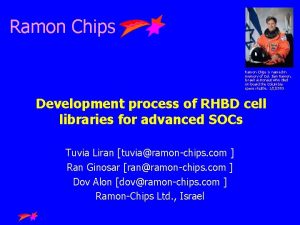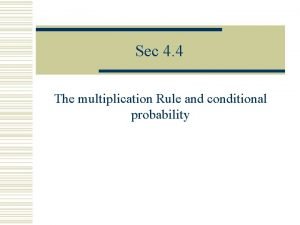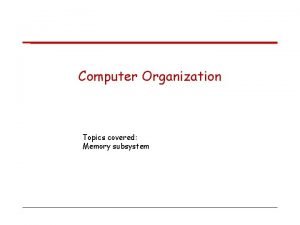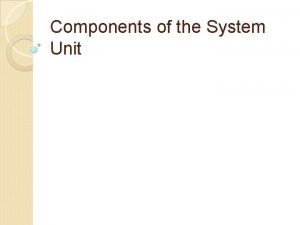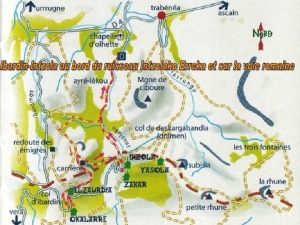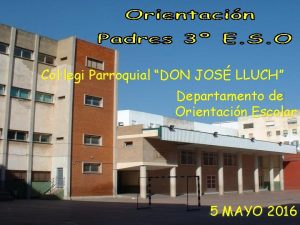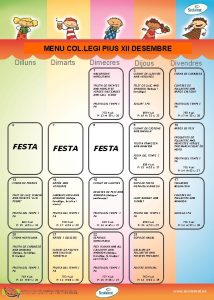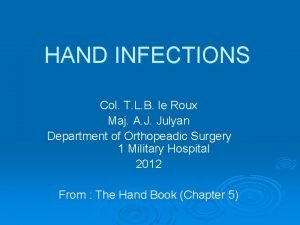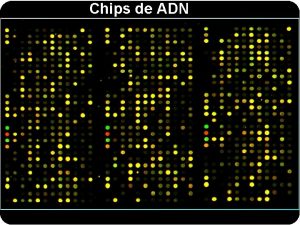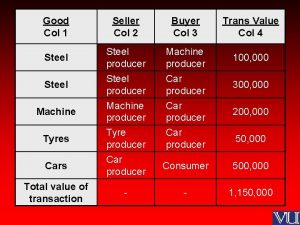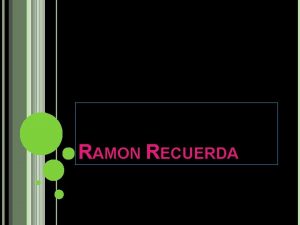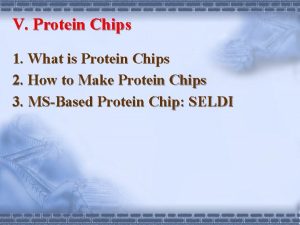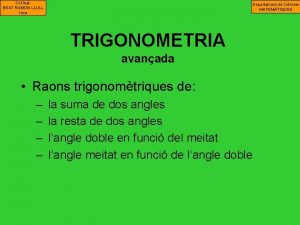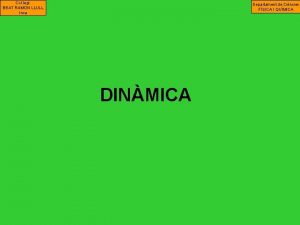Ramon Chips is named in memory of Col










 Me. V*cm Comparing FF alternatives Area Power Tvalid Unprotected LET CLK->out Threshold Errors/bit/day [@LEO](*) Me. V*cm](https://slidetodoc.com/presentation_image/5ee83ed6416b566aaa061d9ae9a959cc/image-11.jpg)











- Slides: 22

Ramon Chips is named in memory of Col. Ilan Ramon, Israeli astronaut who died on board the Columbia space shuttle, 1/2/2003 Development process of RHBD cell libraries for advanced SOCs Tuvia Liran [tuvia@ramon-chips. com ] Ran Ginosar [ran@ramon-chips. com ] Dov Alon [dov@ramon-chips. com ] Ramon-Chips Ltd. , Israel Ramon Chips

About Ramon Chips • • • Private company Based in Haifa; Israel Incorporated in 2004 Developed the Rad. Safe. TM technology Accomplished and delivered several space grade components to customers • Focused on advanced IC design for space Ramon Chips 2

Latest SOC products JPIC JPEG 2000 encoder Ramon Chips GR 712 RC Dual core LEON 3 FT processor 3

Outline • • • Concepts of Rad. Safe. TM technology Rad. Safe. TM libraries Design considerations Development vehicles used Rad. Safe. TM 0. 13µ technology Ramon Chips 4

Rad. Safe. TM concepts • • Radiation Hardening is achieved only by design Same technology for all space applications Based on standard CMOS technology Radiation hardening guaranteed by similarity to previously qualified products/test chips • All IPs fully developed and owned by Ramon Chips • Proven immunity on Tower Semi 0. 18µ technology • Complementary methodologies: § § § Design For Reliability Flow for SEU/SET mitigation Design for testability Electrical screening Class S screening flow Ramon Chips 5

Radiation & Reliability effects mitigated by Rad. Safe. TM • Radiation effects: § § § TID SEL SEU/SET in flip-flops SEU in SRAMs SEFI caused by PLL/DLLs • Reliability effects: § § Electro-migration Thermal cycling Chemical effects Mechanical (shock & vibration) Ramon Chips 6

Mitigating TID effects • Advanced CMOS process – ≤ 0. 18µ with STI • Fixed geometry of transistors – fixed geometry of parasitic devices; insensitive to placement • ~30% area penalty – much less than ELT • TID immunity - >300 Krad(Si) Ramon Chips 7

Performance under TID stress NMOS PMOS TID stress up to 250 Krad(Si) Ramon Chips 8

TID effect on ring oscillator frequency TID(krad) 0 Before Irrad. 13. 4 50 100 150 200 250 300 Ageing 350 Annealing 13. 2 freq. (MHz) 13 Dev #1 Dev #2 Dev #3 Dev #4 Dev #5 12. 8 12. 6 12. 4 12. 2 12 -481 stages of inverters with FO = 4 - Maximum variation in frequency is <0. 5% Ramon Chips 9

Mitigating SEU in flip-flops • • Proprietary circuit Optimized for area and power LET threshold - ≥ 38 Me. V/cm 2/mg SET mitigation by glitch filtering of data SET Filter for clock by several techniques Restricting the use of async Set/Reset All flip-flops on chip accessed by SCAN Ramon Chips 10
 Me. V*cm](https://slidetodoc.com/presentation_image/5ee83ed6416b566aaa061d9ae9a959cc/image-11.jpg)
Comparing FF alternatives Area Power Tvalid Unprotected LET CLK->out Threshold Errors/bit/day [@LEO](*) Me. V*cm 2/mg 1 1 1 2. 94 5 E-7 TMR 4. 01 2. 6 2. 5 - - DMR 2. 48 2. 2 2. 5 - - DMR+ 2. 34 2. 1 2. 5 38. 2 4 E-14 SEP 1. 8 1. 6 1. 2 38. 2 4 E-12 SER (**) 1. 75 1. 2 - - • Relative values • Refers to standard FF, with scan, same output drive (*) Refers to 37 o inclination, quite solar (**) Designed for 0. 13 u only Ramon Chips 11

I/O cell libraries • Two libraries: § For 1. 8 V core voltage § For 3. 3 V core voltage • Special rad-hard ESD cells • Special cells: § § LVDS (>400 MHz) SSTL, HSTL, AGP 5 V tolerance Cold spare • Proven on several chips Ramon Chips 12

Special design rules for I/O cells • RH mitigation: § ≥ 2 guard rings § All NMOS transistors ringed by P+/GND § Special ESD considerations • Other considerations for space ICs: § § Large pitch/size pads – enables thick Al bond wires Relaxed layout rules – reduced thermo-mechanical stress Dual slope transition – reduced ringing Double supply pads – reduced inductance & density Ramon Chips 13

Rad. Safe SRAM cell Many NMOS devices connected to bit-lines Conventional SRAM cell Only PMOS devices connected to bit-lines Ramon Chips Rad. Safe. TM SRAM cell 14

Examples of SRAM cores Ramon Chips 15

SRAM cell libraries • Variable sizes, up to 2 Kx 40 • Two types of SRAM cores: § Single / dual port (>250 MHz / >120 MHz) • • • Two operation voltages: 1. 8 V, 3. 3 V DPRAM performs read & write access per cycle Integrated EDAC & BIST in each core Very low power; zero standby power Protected from all radiation effects: § MBU is eliminated § LET threshold 3 Me. V·cm 2/mg (before EDAC correction) § In tests, all errors corrected by EDAC • Testability features: § § Complementary BIST logic Speed control Weak write Iddq compatibility Ramon Chips 16

All-digital DLL cores • • Three DLL cores for 3 frequency ranges Locking guaranteed & fast Immediate re-locking 0. 05 mm 2/core 8 m. W/core @0. 18 u Highly protected from radiation effects Can be placed anywhere in the core Powered by core supply lines Ramon Chips 17

Technology development chips RADIC 2 • 1. 8/3. 3 V transistors • 1. 8/3. 3 V std. cells • 1. 8/3. 3 V ring oscillators • 1. 8/3. 3 V shift registers • 4 Kbit SRAM • ADDLL • FPGA converted chip RADIC 3 • 1. 8 V transistors • 1. 8 V std. cells • 1. 8 V ring oscillators • 1. 8 V shift registers • Several FF types • 256 Kbit DPRAM • ADDLL • LVDS I/O buffers Ramon Chips GR 702 RC • LEON 3 FT core by GR • Fully automatic flow • 2 Sp. W ports w LVDS • 2 ADDLL • 10 SRAM cores 18

Rad. Safe™ 0. 13µ technology • Density: § Logic - >120 Kgates/mm 2 § SRAMs - >200 Kbit/mm 2 (40 K at 0. 18 m) (80 K at 0. 18 m) • Power - <40% of 0. 18µ • Speed - >200 MHz [for large chips] • Special IPs: § 10 bit, 1 Msps, 1 m. W SAR ADC • Status: § Test chip ready for production Ramon Chips 19

RADIC 4 – Test chip for Rad. Safe_013 technology 3 shift registers 3 delay lines/ SET monitor 10 b RH ADC (1 Msps, 1 m. W) 4 Kx 72 RH SRAM Ramon Chips NMOS/PMOS Xtors 4 Kx 72 RH SRAM With process enhancement 20

10 b Analog to Digital Converter • • Resolution: 10 bit Sampling rate: 0. 5 Msps Power: <1. 5 m. W Area: ~0. 03 mm 2 TID: >300 Krad (target) Process: 0. 13µ Voltage: 3. 3/1. 2 V Ramon Chips 21

Summary • Rad. Safe™ by Ramon Chips § § § Using standard process Using standard EDA tools & flow Proven Rad-Hard-by-design on several chips Optimized for performance, power & reliability RH considerations applies to all levels of design flow 0. 13µ process provides significant performance advantages Ramon Chips 22
 Caracol col col sal de tu casita
Caracol col col sal de tu casita Ramon chips
Ramon chips A box contains black chips and white chips
A box contains black chips and white chips A box contains black chips and white chips
A box contains black chips and white chips Semiconductor ram memories in computer organization
Semiconductor ram memories in computer organization What is the electronic component that interprets
What is the electronic component that interprets Virtual memory and cache memory
Virtual memory and cache memory Prototype in semantics
Prototype in semantics Primary memory and secondary memory
Primary memory and secondary memory Eidetic memory vs iconic memory
Eidetic memory vs iconic memory Virtual memory in memory hierarchy consists of
Virtual memory in memory hierarchy consists of Explicit memory
Explicit memory Physical address vs logical address
Physical address vs logical address Symmetric shared memory architecture
Symmetric shared memory architecture Long term memory vs short term memory
Long term memory vs short term memory Which memory is the actual working memory?
Which memory is the actual working memory? Internal memory and external memory
Internal memory and external memory Intzola
Intzola Moodle don jose lluch
Moodle don jose lluch Col legi pius xii
Col legi pius xii Col verdura
Col verdura Col
Col Colossians 1 15-18
Colossians 1 15-18

